
This part of the front garden border provides lots of colour near the house but I have not planted anything there for years. I first sowed forget-me-nots in the garden over ten years ago and that one sowing was all that was needed to ensure their appearance every spring. Sure they will have to be hauled out later in the year as they get untidy, but it is nice to see them again in spring. I am getting a bit worried about the white alliums though and I think I might have to be more severe this year.
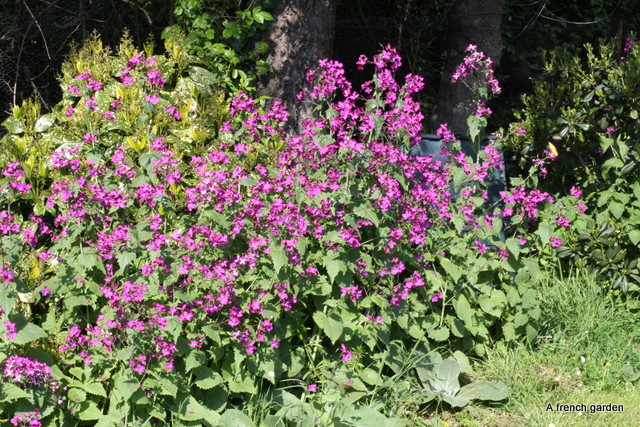
Kourosh flung a handful of Honesty seeds in front of the green plastic composteur and that has created a bright screen that I expect will be self perpetuating.
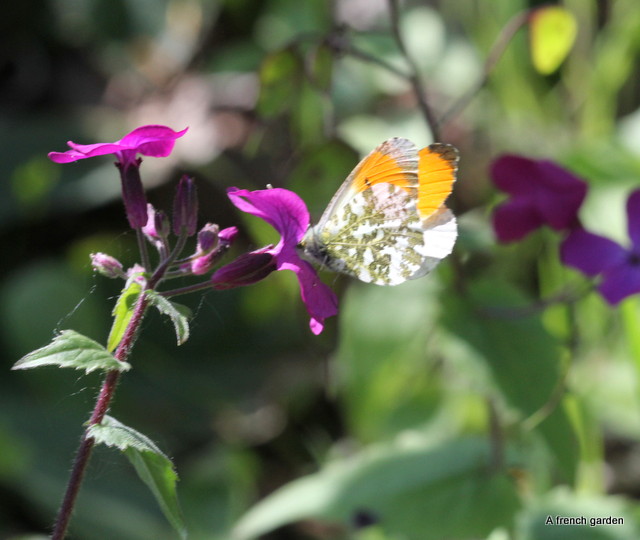
The Honesty is very popular with all the pollinators and I see a lot of orange tip butterflies on it.

This is a male Anthocharis cardamines. They look so good against the purple petals, I wonder if he is just showing off.
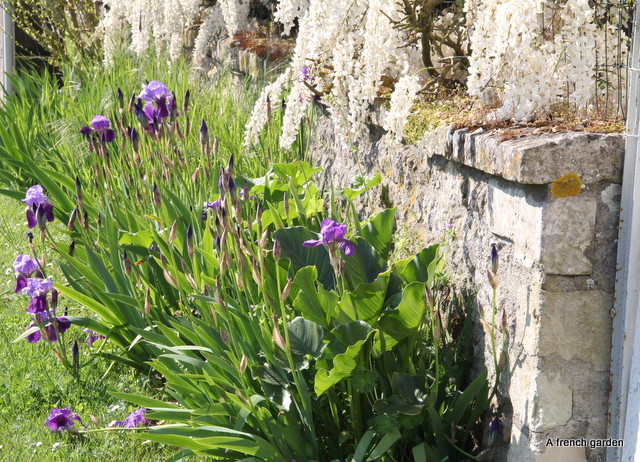
The purple Iris outside the front walls are beautiful and provide lots of colour but I have a difference of opinion with Kourosh here that they create too much work. After the flowers have past I find that Iris stems provide ideal nursery spaces for all sorts of weeds and prevent efficient strimming along the base of the wall.
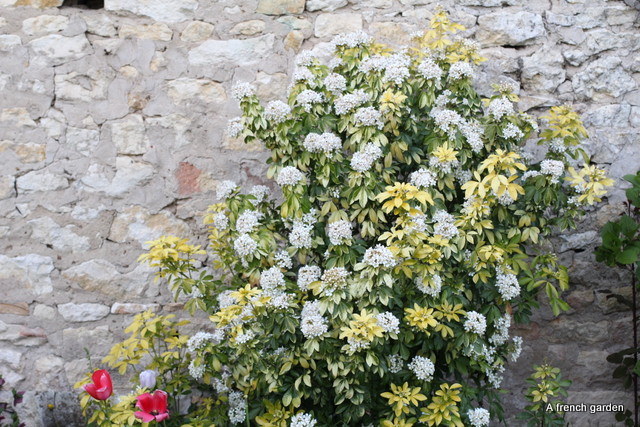
Contrary to the Iris, is the Choisya “Sundance” which is in flower just now and is a workhorse. It gives you perfumed flowers and the yellow, evergreen foliage light up the winter garden.
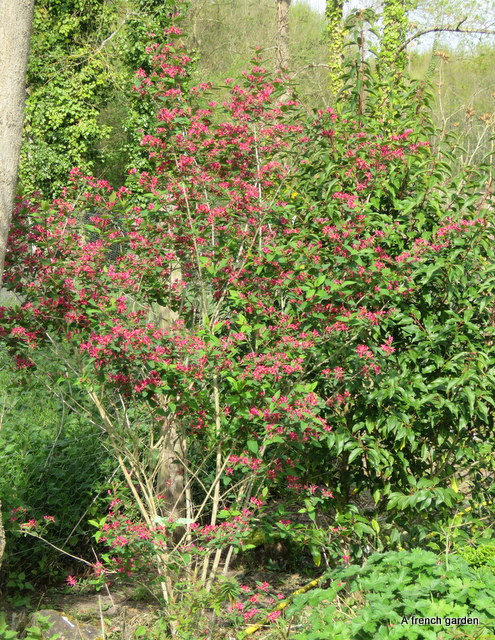
Another impressive evergreen is my Lonicera tatarica. It is in flower just now and survives in a dry, shaded spot in the back garden.
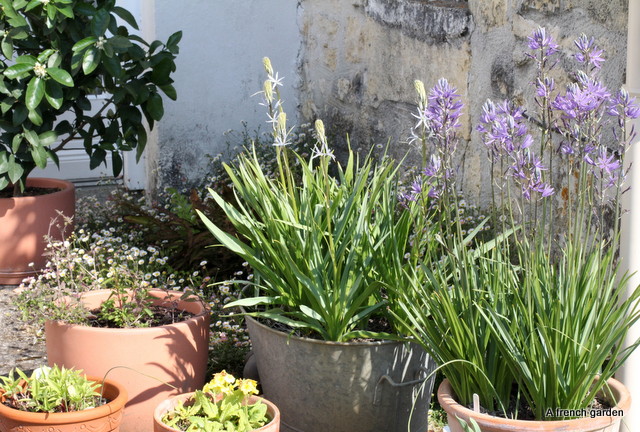
I don’t keep too many pots, but I love to have pots of Camassia on the patio at this time of year. They attract a lot of bumble bees, so as soon as the sun is out in the morning we are out with a coffee and the bees are on the Camassia.

The queen bumble bees make a lot of noise as they go about their morning tasks.
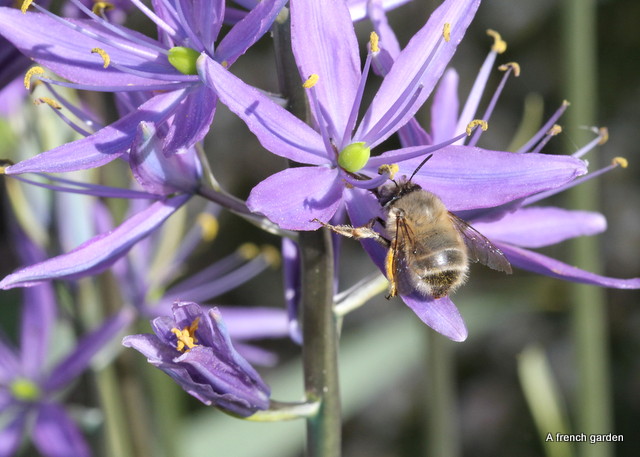
The Anthophora bees are frequent visitors too. This could even be a female A. plumipes as we have only the grey females here.
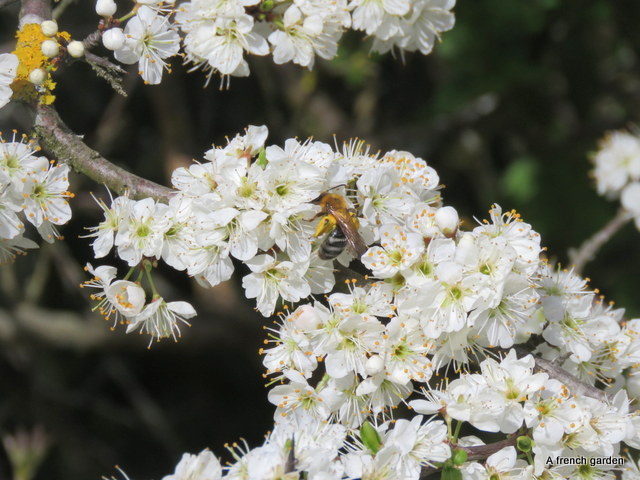
In the back garden it is the Victoria plum tree that attracts the bees at the moment.
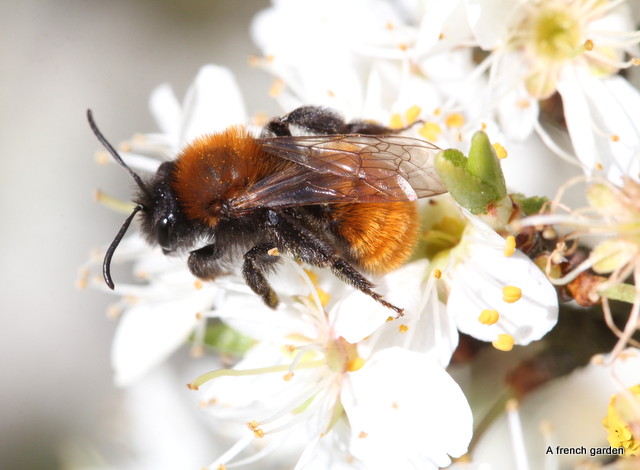
I am pretty sure that this is an Andrena fulva.

However, this one I am not so sure of, but it might be an Andrena flavipes or Andrena nitida – see comments. All comers are very welcome on the plum tree.
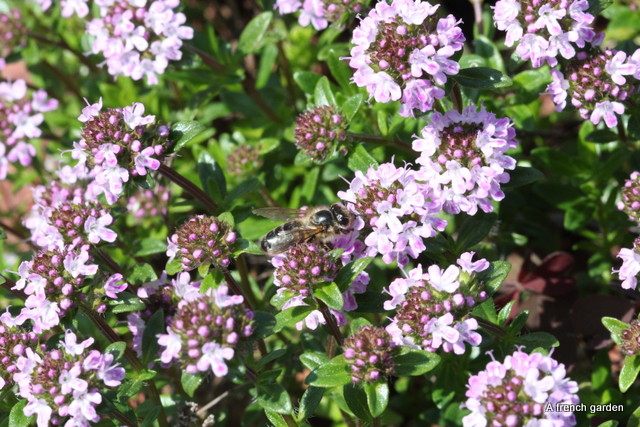
Another flower attracting all comers is the thyme.
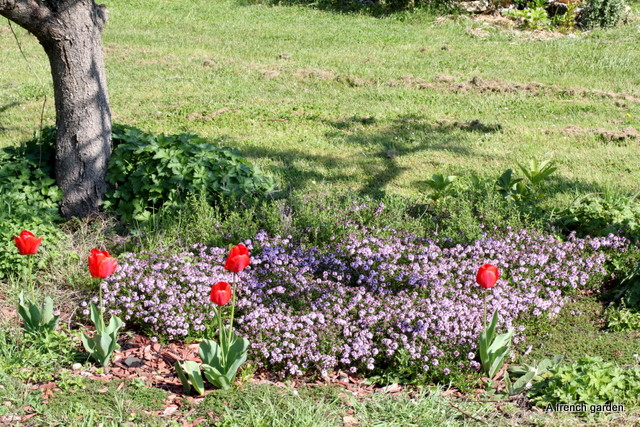
I started this thyme off to cover a difficult patch between two tree. I had already tried other options but this is thyme taken from patches growing wild in the garden and I have supported it by covering the edges with wood chip. The tulips are from a previous idea and I’ll let them fight it out themselves as they seem pretty determined.
I am very happy with its spread and I am considering using it in other places to inhibit weeds in sunny spots.
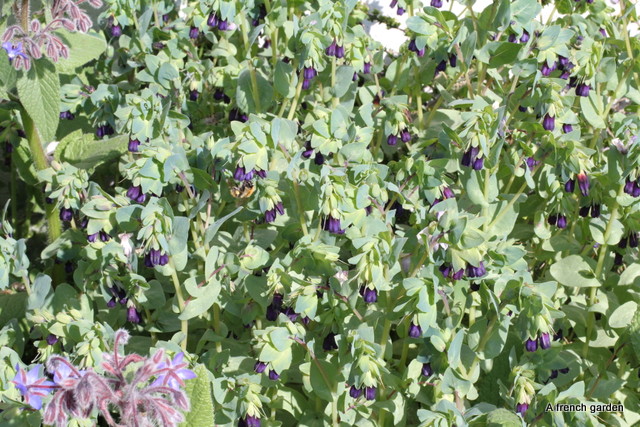
This is a clump of self-sown Cerinthe. Probably the biggest draw for solitary bees in the garden at the moment. It is so thickly sown that it has completely suppressed weeds (well the nasty ones, I am not counting the borage and a bit of fumitory). So, I cannot ask for more colour or more bees from this clump of flowers.

I wonder whether thyme could cope with clay soil? I have been looking for a ground cover plant for my mother’s garden and you’ve made me think thyme might do the trick.
LikeLike
My soil is sandy and very dry in the summer and never gets waterlogged. If the clay soil stays wet then the thyme might not work as well. I also use Hellebore and they work here in sun and in the shade. I am always on the look out for ground cover plants that do not run riot. Amelia
LikeLike
I haven’t seen any Orange tips yet but I seem to have plenty of Brimstones. I am so impressed how you can identify all your bees. I have to say I agree with Kourosh, the irises look lovely along the wall.
LikeLiked by 2 people
I cannot identify all the bees I see. Some are more distinctive than others. If I really wanted to identify more, I would have to catch them and preserve them so that I could look at all the intricate details that allows you to identify them. I have not quite got the heart for that yet. Amelia
LikeLike
Love the honesty. It is such an important early food plant and beautiful when seeding!
LikeLiked by 1 person
I’m a great fan of Honesty. You cannot ask much more of a plant. Amelia
LikeLike
Camassias in pots is a good idea; I love them but it is too dry for them in the garden, maybe I’ll try a few next year. What do you do with yours when they stop flowering?
LikeLiked by 1 person
The ones in the photograph were left since last year in the same pot. I think I may have to repot them this autumn, though. I have also a larger aluminium pot with some caerulea and cusickii that I planted up in autumn 2017 and are just coming up again. I have not been as lucky with the ones I have put in the ground but it was a very dry area. Some might have survived and I am keeping my eye open to see if any survive. Amelia
LikeLiked by 1 person
I just got a bee and butterfly house and was looking for plants that would attract them. Your post was perfect timing to read for some ideas. Thank you
LikeLike
I’m sure you will get a lot of fun out of your new house. You do not say if you made it yourself or bought it. I have found I need holes or bamboo tubes at least 10 cm (4 inches) long to attract bees and some of the bought houses are too narrow. The plants to attract bees vary greatly according to location, so now is a great time to check out your parks and gardens nearby to see what is working well in your area. Amelia
LikeLike
Beautiful pictures, especially of the orange tips.
In the UK, Andrena flavipes would have much more distinct abdominal bands, your picture looks a bit like a UK Andrena nitida.
LikeLiked by 1 person
Thanks Philip, I can see light white hairs on other photographs on the abdomen but certainly not distinct banding so I think you must be correct. I love to see the bees full of pollen but it does not help us with identification. Amelia
LikeLike
What a great variety of life! What resources do you use to identify the plants and animals?
LikeLike
Obviously the web helps but for the bees it is Field Guide to the Bees of Great Britain and Ireland by Steven Falk, as there is nothing to touch it in Europe. He also has a web site. For the birds it is Guide des Oiseaux de Poitou-Charentes et Vendée. Butterflies is Butterflies of Europe, Tristan Lafranchis and http://www.papillon-poitou-charentes.org. Of couse, I make mistakes and I get a lot of help from my readers. Amelia
LikeLike
Someone who used to work where I now work part time used to toss seed of honesty about. He collected it while available, and tossed it out where he thought it would be nice. Since he has been gone for several years, the honesty is becoming less common. I intend to collect some seed this year, just so that it does not disappear completely. I will not be there long enough to make much of a difference, but perhaps I can keep it going long enough for someone else to take over. I do not know who started the tradition, but it is a good one.
LikeLiked by 1 person
What a lovely idea! I’m sure it will be admired in the future but we will not know who by. Amelia
LikeLiked by 1 person
Lovely, Amelia. Saw out first orange-tip in the garden today (in Dorset). RH
LikeLiked by 1 person
We seem to have more butterflies around at the moment. I think it must be this very mild spring. Amelia
LikeLike
Love all of these gorgeous photos. And glad to see the bees are thriving in your garden! I’ll have to try the Camassia. I’m embarrassed to say I’ve never grown it though it grows well in the US’s Pacific Northwest. Thanks for the post, cheers.
LikeLiked by 1 person
I’ve put the Camassia in the garden too but it does not flower, I think it is too dry for it. I love it so much I have to put it in pots. Amelia
LikeLike